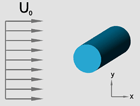





















|
|
|
Drag Force
Cylindrical Needle
For a cylindrical needle with a very large ratio of length to
radius ratio, moving transverse to its axis as shown in Figure 10, the
drag per unit length is given as

| (26) |
where  and a is the radius. and a is the radius.

|
|
| Calculation Model |
 |
Drag - Cylindrical Needle

|
 |
|
Particle Shape Factor
The ratio of the resistance of a given particle to that of
a spherical particle having the same volume is called the
dynamic shape factor of the particle K. The radius of an
equal volume sphere is referred to as the equivalent radius re.
Clearly

| (27) |

| (28) |
Hence,

| (29) |

| (30) |
The Stokes (sedimentation) radius of a particle is the radius of
a sphere with the same density, which is settling with the terminal velocity
of the particle in a quiescent fluid. Values of shaped factors
for a number of particles are available. (Hidy, 1984; Lerman, 1979).
|























 and a is the radius.
and a is the radius.








